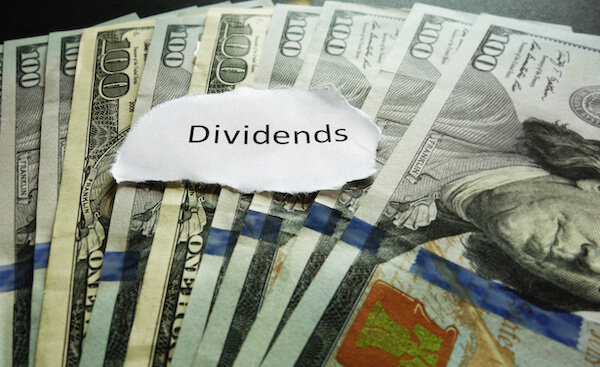
Have you ever thought about passive income? We’re not talking about those scammy ads. Dividends are one of the few proven ways to get cash flows without having to devote continuous effort. But unless you are a trust-fund baby, building a dividend income takes time, money, and a well-executed strategy.
In this post, we explain what dividend investing is, where to find dividend stocks, and how you can build your own dividend investing strategy.
What Is Dividend Investing?
In the stock market, your total return on an investment consists of two parts: capital gains and dividend payments. Dividend investing focuses on stocks that consistently pay cash dividends.
Most investors buy a stock expecting its price to rise. A capital gain is the difference between what an investor paid to buy a stock and the share price for which they sell that stock.
In theory, the price of any stock can go up, but investors who seek capital gains usually look for growth stocks. As the name implies, these are stocks of companies that expect lots of growth. The best example would be a tech company, which might be posting losses today yet is poised to become a profitable business in the future.
In contrast, a dividend investing strategy does not rely on future stock price appreciation. Instead, dividend investors seek to buy and hold dividend-paying stocks. This strategy focuses on creating a reliable income stream.
Unlike growth stocks, the best dividend stocks are mature companies with stable cash flows. These companies might not have a high potential for further growth, but their current operations can already support dividend payments. And more importantly, these companies are here to stay. Some dividend stocks are over 100 years old.
Dividend investors typically prefer certain types of stocks that are known for good dividends. These include the following:
- REITs: REIT stands for real estate investment trust. REITs are real estate stocks that hold portfolios of properties. REIT stocks are exempt from taxes on rental income. Yet to keep that special tax status, they must maintain a high dividend payout ratio, i.e., they must funnel a certain percentage of their income into dividends.
- Utilities stocks: Companies that provide basic utilities such as water, natural gas, and electricity are natural monopolies. While these companies are heavily regulated, they generate predictable cash flows and pay stable dividends.
- Telecom stocks: Decades ago, mobile carriers were fast-growing businesses, but now they are more akin to utilities. For most of us, a smartphone is almost as necessary as running water. Recurring, predictable cash flows from subscribers make telecom stocks reliable dividend payers.
- Consumer goods stocks: Companies that manufacture and sell basic consumer staples are another category of dividend stocks. This includes retailers such as Costco (NASDAQ:COST) as well as manufacturers of tobacco, beverages, and of course food. These stocks usually do well in any economy.
- Pharma stocks: Pharmaceutical companies tend to do well in any market because consumers rarely try to eliminate drugs and related treatments. Patent protection also can help these companies maintain high profit margins. In turn, predictable incomes and healthy margins ensure that pharmaceutical companies have enough cash to pay dividends.
- Raw materials stocks: Metals, minerals, chemicals, and other materials are raw materials for industrial goods, which in turn are used to manufacture consumer goods. This means raw materials are always in demand and raw materials companies can pay decent dividends. During periods of strong economic growth, in addition to paying dividends, these stock prices can rise with commodity prices.
- Dividend Aristocrats: These companies are members of the S&P 500 index that have at least 25 consecutive years of dividend growth. These are blue-chip stocks with strong, resilient businesses that have weathered lots of economic crises. Examples include the Coca-Cola Company (NYSE:KO), Caterpillar (NYSE:CAT), Exxon Mobil (NYSE:XOM), and other major brands.
While lots of stocks might fall into these categories, the great benefit of a dividend investing strategy is that dividend investors don’t need to check stock prices every day and worry about volatility. Ideally, you should be happy to hold your dividend stocks for a long time.
As a dividend investor, you also will do more than just look at a stock’s share price. Most dividend investors typically focus instead on the dividend yield.
What Is Dividend Yield?

The dividend yield is an important metric that measures the yield produced by a stock.
To calculate it, combine the annual dividend with any special dividend and divide this sum by the current share price. Dividend yield is usually expressed as a percentage.
There are two components to a high dividend yield: a low share price and a high dividend.
However, a higher yield is not necessarily good because it could be due to a low and declining share price. And a low company valuation might be a sign of problems with either its balance sheet or the underlying business. If that’s the case, dividend cuts might be around the corner, and that would reduce the dividend yield.
To prevent such situations, any dividend investing strategy should start with research.
How to Build Your Dividend Investing Strategy in 5 Steps

The process of building your own dividend investing strategy can be broken down into the following five steps:
- Research stocks: This typically starts with looking for stocks from specific categories (listed above). Investors look at business fundamentals and balance sheet strength, seeking to find stocks that will continue to pay consistent dividends. The current share price is often a secondary consideration. The aim is to buy stocks of high-quality companies that offer attractive dividend yields at a reasonable share price.
- Get adequate diversification: Aim to build an investment portfolio across different sectors. It might be tempting to simply buy a dividend mutual fund or an exchange-traded fund (ETF) that invests in a range of dividend stocks and call it a day. But that convenience comes at a cost. Expense ratios and fees for these funds are higher than for plain-vanilla index funds.
- Hold for the long term: Dividend investors don’t actively trade. By holding stocks for at least six months, investors can treat their dividends as qualified dividends. This status grants a lower tax rate than the rate for ordinary income.
- Watch out for dividend cuts: Some dividend cuts might be temporary and due to changes in the market or business cycle. In other cases, a dividend cut might be the beginning of a long-term decline for either the company or the whole industry. Regardless, a dividend cut is a signal to reevaluate your position in that stock.
- Let the compounding magic work: Use some of your dividends to buy more dividend stocks. Even partial reinvestment of dividends would quickly compound and help to grow your investment portfolio.
Perhaps most importantly, remember that each of these steps takes time. Cutting corners doesn’t pay when you’re building a long-term investment strategy.
Lay the Foundations for Your Investment Strategy
This post has explained dividend investing. We’ve explored sectors that offer some of the best dividend stocks, defined the dividend yield, and outlined the path toward building your own dividend investing strategy.
Research is always the first step for any investing strategy. Sadly, there is often too much conflicting information, frequently produced by fund managers and brokers who mainly care about their fees, not your income.
But you also don’t have to do all the research on your own. Starting October 1st, Investors Alley is hosting an online education course with four live classes, handouts, and homework. This course will help new investors learn about income investing. If you’re planning to build an income investment portfolio, the Forever Dividends Masterclass is a great starting point.





